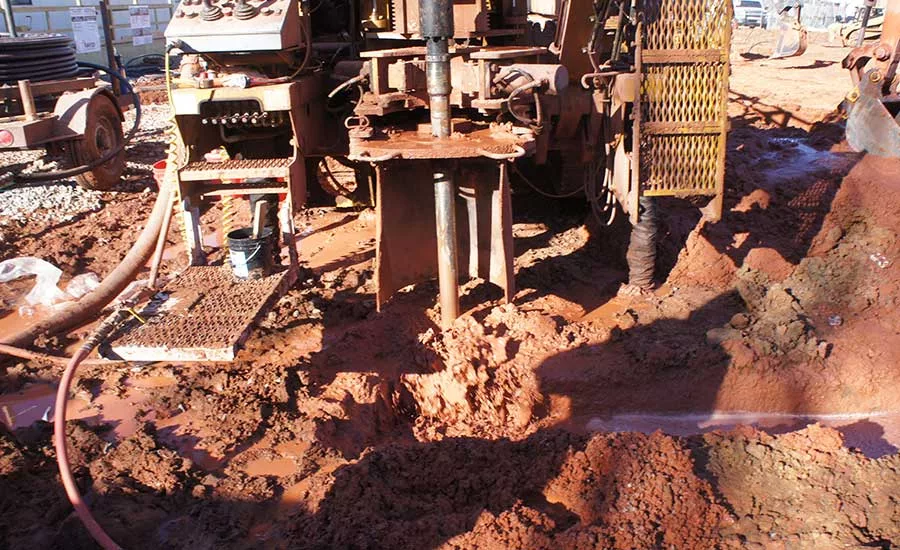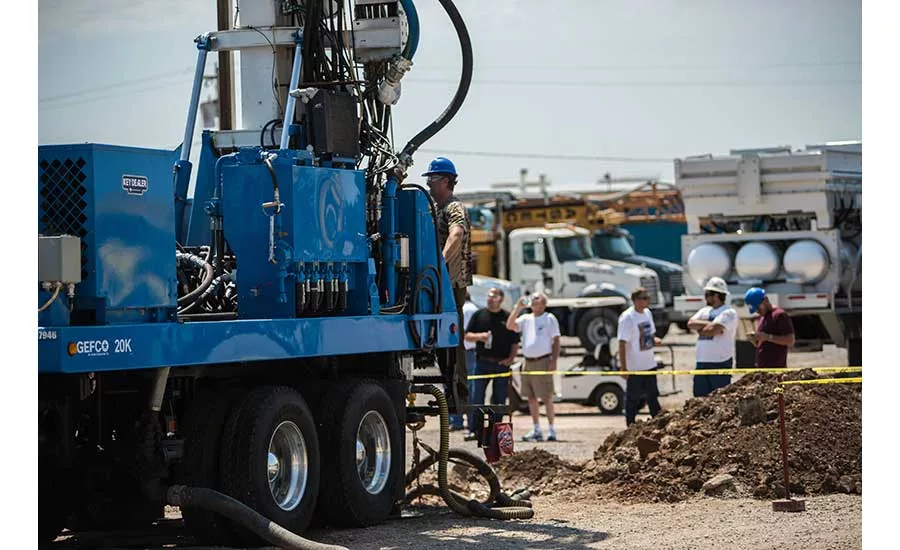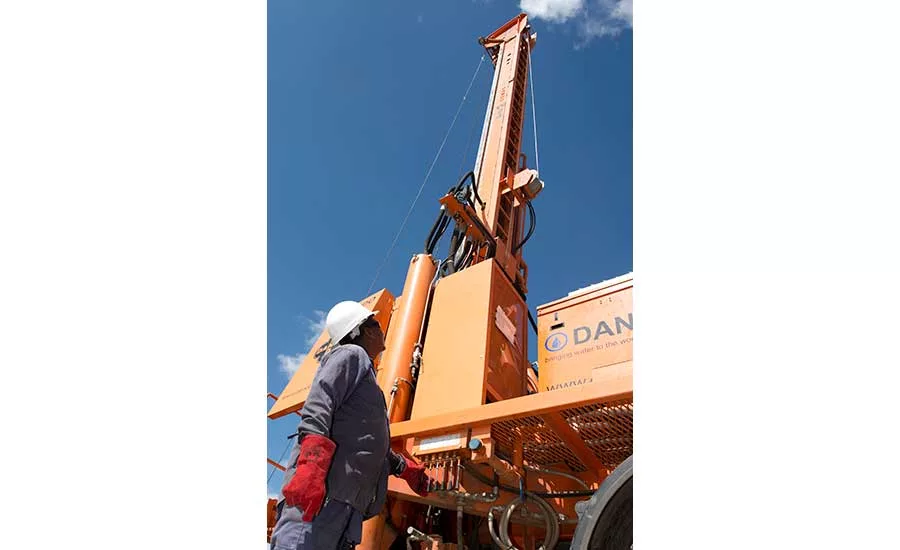Hole Cleaning Tips to Efficiently Surface Cuttings on Drilling Jobs

Whether drilling water well, geothermal or construction, the goal is an efficient borehole that makes the most of the tooling and equipment on site. Source: Brock Yordy

A good driller understands the potential productivity of the rig and tooling on site. Source: Brock Yordy

No matter what location or formation, a main goal needs to be creating a cutting that can easily be removed from the hole. Source: Staff. Sgt. Christopher Ruano / U.S. Air Force
This summer, I have spent much time in the field working with drillers on water well, geothermal, construction and cathodic projects. Regardless of the geographic location, I always approach a project with this goal in mind: To drill an efficient borehole safely utilizing the tooling and equipment on site with the least amount of impact to the environment. As a drilling trainer, I understand that the ideal equipment and tools to complete the job the most efficient way may not be available. It is equally important to comprehend that there are multiple ways to drill a hole, and the equipment and tools on site are best because they are available right now. The key is adjusting your expectations — and the customer’s expectations — of how much time is required to complete the hole. No matter what technology, tooling or equipment is on site, the basic principle stays the same: to drill the formation by creating a drill cutting that can easily be removed from the borehole. To keep with that principle, we must understand the cutting action of the bit, how it reacts to the geological formations and how the cutting is removed from the hole.
The best-designed drill rigs in the world are only as good as the drill bit. Drilling was revolutionized when Howard Hughes introduced the tri-cone drill bit. This innovation had 100-percent market dominance until the patent ran out. The next significant improvement was tungsten carbide inserts, which improved the cutting action and life of the bit. Now the industry has progressed to diamond tips, other hardening features, and hybrid bit types to cut a hole anywhere.
Today, every good drilling company has multiple drill bits in their toolbox. These bits range from roller cone styles such as mill tooth tri-cone, button tooth tri-cone or fixed cutter-type bits like drag bits and polycrystalline diamond compact (PDC) bits. Drag bits and mill tooth are suited for soft formations. Button tri-cones and PDCs are more suited for hard formations. Hybrid bits such as PDC/drag combinations allow for drilling soft to medium to hard formations. The goal is to choose a bit that can create a 1-inch size cutting while maintaining a steady penetration rate.
If the bit is creating a cutting larger than 1 inch, we must slow down penetration and increase rotation. When penetration rates slow down, our first reaction is to increase down pressure. However, first, we have to consider why drilling has slowed down and what new downhole issues can be created by increasing down pressure. More pressure can help push through a hard layer. However, if that hard layer becomes more than a few feet the bit starts to heat up and wear in ways not intended by the manufacturer. Also, increased down pressure will cause flexing in the drill rod that can cause the bit to jump. Bit life can be significantly improved and rod flex can be prevented by utilizing drill collars and a proper stabilizer. Consult with your bit manufacturer about how your bits are wearing. Bit manufacturers want to see how bits are wearing or deteriorating under stress. It helps them with future product improvements.
When penetration rates slow down, our first reaction is to increase down pressure. However, first, we have to consider why drilling has slowed down and what new downhole issues can be created by increasing down pressure.
Next, we need to consider how the geology reacts to the bit’s cutting action and the drilling fluid to create a solid. My mentors at Baroid IDP describe these solids as large solids and small solids. Small solids, or reactive solids, include clays, shales and silts. These solids react to water either by breaking down or becoming sticky. Reactive solids require aggressive cutting and mixing to create solids that can quickly move up the hole. Large solids, or non-reactive solids, include sands, gravels and rock. They do not react to water because of their porosity. Proper downhole adjustments, such as penetration rate and fluid output, have to be considered to prevent hole erosion on sands and gravels because of their porous nature. These modifications can be made by utilizing the right fluid for the given formation. Air can move cuttings 10 times faster up hole than mud, but if the formation is fragile air can cause 10 times more damage than mud.
Selection of the proper flushing media must take into account the formation porosity and depth to water. The target up-hole velocity for mud is 60 to 150 feet per minute, whereas air is 1,500 feet per minute and greater. When cuttings are heavier, drilling fluids can be designed to help with carrying the cuttings to surface in both air and mud. With air, injecting water or foam will increase the air’s carrying capacity and help lift heavier cuttings. In mud, the increased gel strengths of bentonite- or polymer-based carrying agents can assist in moving solid to the surface.
Hole cleaning starts at the bottom of the hole when cuttings are created and the fluid jets those cuttings past the bit and up the hole. Next, velocity of the fluid carries the cuttings to surface. The slower the cuttings move to the surface, the more time the cuttings have to deteriorate into smaller pieces. Proper up-hole velocity will determine the successful completion of a borehole. It is important to know the maximum output of your air compressor and mud pump. Next, bit diameter combined with inner and outer tooling diameter will determine how much up-hole velocity is available to clean the hole. The deeper the borehole, the longer it will take for cuttings to reach the surface. A 300-gallon-per-minute mud pump up-hole velocity with an 8-inch bit and 3.5-inch drill pipe is 142 feet per minute, and a 12-inch bit with that same 3.5-inch drill pipe is 55 feet per minute. The 8-inch bit has adequate up-hole velocity, but the 12-inch bit falls below our required up-hole velocity of 60 to 150 feet per minute. Although 55 feet per minute is close to our minimum up-hole velocity, the factors we forget to take into consideration are fluid viscosity and density. Yes, before we start creating drill solids our pump is close to optimal output, but the deeper we drill, the reactivity of the solids will decrease our pump’s efficacy.
A good driller understands the productivity and limitations of the rig and tooling on site. I suggest using a stopwatch to better understand your equipment performance. Time how long cuttings take to move from bit to surface. Once you have a good baseline, you can adjust rotation and penetration rates accordingly. In ideal situations, we have the correct bit for the geology and it is paired with optimal up-hole velocity. When that happens, it is easy to drill any borehole. But when ideal equipment is not available, we must be prepared to adjust our expectations of how long it will take to drill the hole. It all comes back to, how much time can you afford to spend on one project?
Looking for a reprint of this article?
From high-res PDFs to custom plaques, order your copy today!





